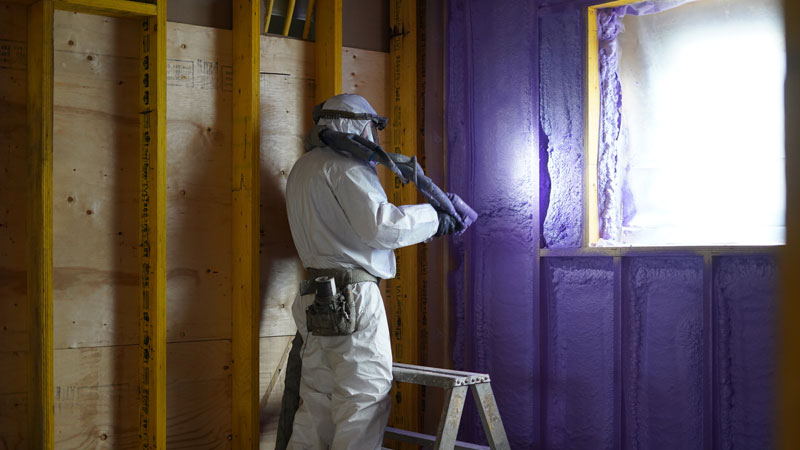Are your utility bills skyrocketing with the weather, or is there no rest from noise pollution, making being in your home uncomfortable? Amidst rising utility costs in Alberta, choosing the right insulation during renovations can be a game-changer. Spray foam insulation not only cuts down on energy expenses but also helps create a quieter, more serene living space. Here’s what to know about spray foam insulation installations in your home.
Can You Use Spray Foam Insulation Around Electrical Boxes?
You can safely use spray foam insulation around electrical wires and boxes, but it isn’t something to try without training. Preparation is everything! Before you begin, know the type of wiring you’re possibly coming in contact with and prep any boxes and panels so the foam cannot enter and be next to connections.
Generally speaking, wiring is safe to be in contact with, except in instances with very old knob and tube wiring. If you’re not sure what wiring your home has, ask us! Properly applied spray foam insulation provides an airtight seal, improving your home’s energy efficiency by preventing air leaks and drafts. Closed-cell spray foam insulation application should consider the following:
- Create a Seal: Spray foam creates an effective seal to prevent air leaks, enhancing energy efficiency and maintaining consistent indoor temperatures.
- Accessibility: Always leave access to junction boxes. Do not spray overtop fixtures that are not rated for direct contact. We recommend going a step further since spray foam is a liquid applied. It is far safer to create a barrier overtop of fixtures, such as pot lights, prior to spraying.
- Application: Spray around the electrical box, not inside, and avoid overfilling to prevent unwanted pressure. This ensures that the electrical connections remain secure and accessible.
- Building Codes: Always check local codes and consider pre-inspections to check for any existing wiring issues. Compliance with regulations ensures safety and reliability.
1/2lb spray foam insulation can also be an air barrier for your home, protecting your electrical system and home, while also acting helping with noise pollution. If you want to upgrade your spray foam wall insulation during a renovation or a new building, reach out today to request a quote from our experts!

Can You Leave Spray Foam Insulation Exposed?
In many cases, spray foam insulation should be covered by a thermal barrier, such as a spray-on thermal barrier, mineral wool or drywall. This is key for protecting your and your family’s safety in a fire, as it provides more time to evacuate. Always check with your local jurisdictional requirements, or ask the experts! As you plan, consider where the spray foam will be applied:
- Living Spaces: If the insulation is in living areas or storage spaces, it should be covered. This can include warm crawlspaces or attics designed to supply the home with plumbing and heat. It’s essential to understand the difference. You must also protect the foam from areas next to air returns. Should there be a fire, it’s code to allow more time before harmful smoke can be pulled back into the furnace and redistributed throughout the home.
- Cold Attics and Crawl Spaces: These areas often don’t require covering, but it’s always best to check local regulations. Exposed foam in these non-living areas is typically acceptable.
If you’re looking for a second opinion, our spray foam experts are here to help answer any questions you have and find the areas in your home where the heat is escaping before we begin.
Can You Spray Foam Insulation Over Electrical Wires?
Yes, spray foam insulation can be used over electrical wires, but keep these considerations in mind:
- Type of Foam: Closed-cell foam is used for better insulation and rigidity, and open-cell foam is used for flexibility. Closed-cell foam is denser and provides a higher R-value, while open-cell foam is softer and better for filling nooks and crannies.
- Future Access: Think about future accessibility for repairs. Encasing wires can make future work more challenging.
- Code Compliance: Always follow local building codes. This ensures that your installation meets all safety standards.
- Professional Installation: Hiring professionals ensures a safe and proper application. Expert installers know the best practices to avoid damaging the wires.
How Many Inches of Spray Foam Insulation Do I Need?
The thickness of spray foam insulation depends on the area of application, Alberta code requirements, and your insulating goals:
- Walls: 2-4 inches of closed-cell foam is typically sufficient for walls, providing excellent thermal resistance and structural support.
- Roof Deck: 4-7 inches for optimal insulation. This thickness helps protect against heat loss in winter and heat gain in summer.
Spray foam insulation has a long lifespan, as it doesn’t sag or break over time, providing a durable and long-lasting solution for your home. A professional assessment will help determine the right amount for your home’s needs.
At Thermo Solutions, we deliver quality installations and industry-leading material selections for every insulation job. Our products will outperform your expectations, from slabs to attics, walls, joists, and cantilevers. Can we help with your next spray foam insulation installation? Contact us today for a free estimate!
